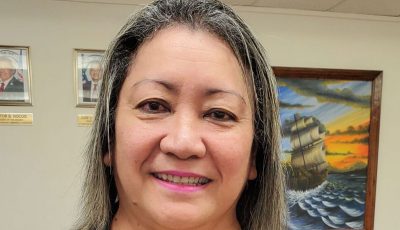‘No sign of recovery yet for affected corals in Saipan lagoon’
Reefs in Northern Islands experienced bleaching, high mortality
Coral bleaching is fast becoming a major issue in various waters of the world and the Pacific Ocean is in the frontlines.
Recently, the famous Great Barrier Reef of Australia made headlines as scientists revealed that a staggering 93 percent of the Reef has been hit by coral bleaching.
Damage ranged from very severe to little from the north to south along the 2,300-kilometer length of the Reef. Some remote areas of the reef had an average of close to 50 percent mortality of bleached corals, with some reefs having a final death toll likely to exceed 90 percent, according to a report from the Australian Research Council’s Centre of Excellence for Coral Reef Studies.
Coral bleaching is triggered by too warm sea temperatures which kill the zooxanthellae—the tiny, colorful marine algae, which live inside corals, providing them with much of their color and, most importantly, their primary supply of energy. Without these algae, coral tissue becomes transparent, revealing the white coral skeleton. Corals can die if unfavorable conditions persist.
The New York Times reported the National Oceanic and Atmospheric Administration saying that we are experiencing the longest global coral bleaching event ever observed.
It added that damaged or dying reefs have been found from Réunion, off the coast of Madagascar, to East Flores, Indonesia, and from Guam and Hawaii in the Pacific to the Florida Keys in the Atlantic.
No sign of recovery
In the CNMI, consecutive thermal stress and bleaching events since the summers of 2013 and 2014 were experienced.
“The staghorn Acropora spp. corals in the Saipan lagoon, which we are able to monitor fairly regularly, bleached severely in 2013, largely recovered during the winter months and then presumably bleached again in 2014 and largely died,” Bureau of Environmental and Coastal Quality lead marine biologist Lyza Johnston said.
“We lost over 85 percent of staghorn Acropora corals at long-term monitoring sites in the Saipan lagoon in this two-year period. Some other species in the lagoon, such as Isopora palifera, suffered some mortality as well,” she added.
BECQ monitor sites across Saipan, Tinian, and Rota every year. As of the 2015 data, there were no indications of recovery for corals just yet particularly in the Saipan lagoon.
“There was a lot of mortality in the Saipan lagoon of the staghorn corals and other sensitive species and there is no indication of recovery yet, but it will likely take a few years before we can detect growth. But, we are actively monitoring for any signs of recovery in the lagoon,” Johnston said.
Bleaching, high mortality in CNMI reefs
Some areas in the Northern Islands suffered bleaching and had high mortality rate based on the latest taken on the summer of 2014.
BECQ surveyed seven of the northern volcanic islands of the Mariana archipelago from June 21 to July 19, 2014, including the island of Maug where some of the most highly developed and diverse coral reef systems in the northern volcanic islands are located.
“During the first trip, we saw moderate to severe active bleaching on several of the more northern islands, largely restricted to shallow water (above 10 meters). We also found that the more southern islands of Sarigan, Guguan, and Anatahan had experienced mass mortality of shallow water coral assemblages, likely due to the 2013 thermal stress event (as evident from standing dead coral colonies),” Johnston said.
“When we returned to Maug in August 2014, the reefs were severely bleached and there was already high mortality of the more sensitive species,” she added, “Percent corals bleached ranged from 85 percent to 95 percent across sites. Nearly all species were affected to depths of at least 20 meters.”
According to BECQ, the health of the coral reefs across the northern volcanic islands of the CNMI appears to be in decline overall.
BECQ is yet to return to the Northern Islands for further assessment.
“We don’t know if the bleached reefs in the Northern Islands recovered or not,” Johnston said, “We would love to get back up to the northern islands to see how they are doing post bleaching, but we have not identified a source of funding to do so yet.”
Keeping ecosystems healthy
While coral reef resilience is largely dependent of the overall health of the ecosystem, BECQ said evidence suggests that reducing or eliminating local stressors such as pollution and overfishing may greatly improve the resilience of reefs to climate change.
“We need to keep the corals and the reefs healthy by reducing land-based sources of pollution and supporting healthy herbivore populations. Corals that are exposed to increased nutrients and sedimentation are less resilient to thermal stress and bleach faster. Corals also compete with macroalgae for space so it’s important to have herbivorous fish and urchins to control growth of macroalgae so that the corals can recover from disturbance events,” Johnston said.
While there are those who are studying the aquaculture of coral reefs with coral farming or gardening, such program is yet to be looked into in the CNMI.
“Currently, there are no coral culturing or restoration programs in the CNMI, but we are actively exploring that option for the future,” Johnston said.
According to BECQ, the consecutive mass bleaching and mortality events across a region with little human influence highlight the importance of managing for coral reef resilience. It added that the CNMI is leading the way in these efforts, conducting one of the first field based coral reef resilience assessments to inform management.
Johnston added that she hopes to get a comprehensive “state-of-the-reef” report for the CNMI this 2016.



























